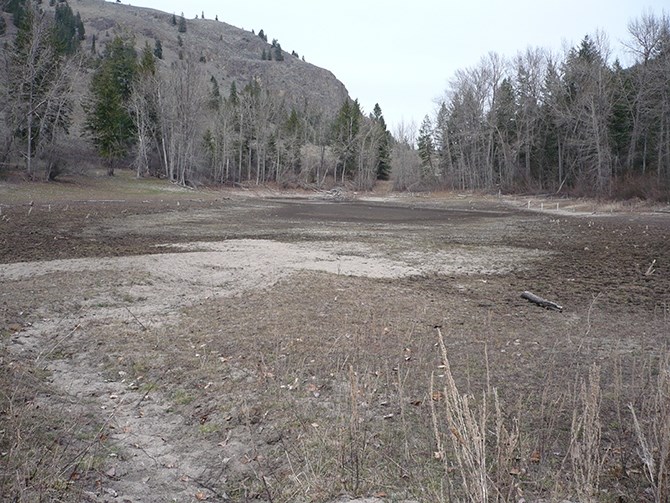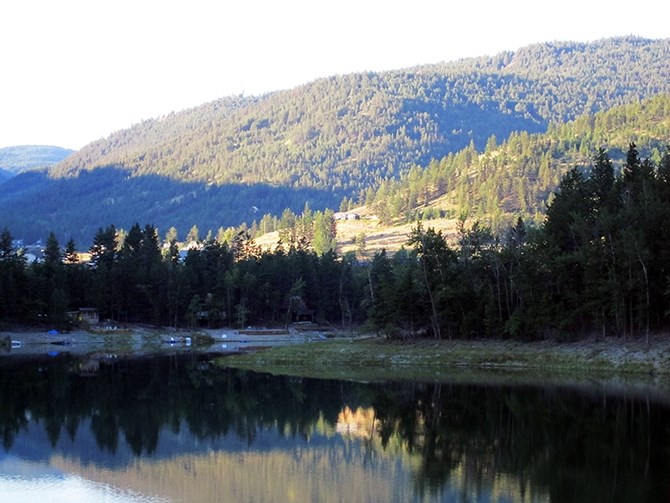
Twin Lakes water level today.
(STEVE ARSTAD / iNFOnews.ca)
July 06, 2016 - 1:11 PM
PENTICTON - It’s showdown time at the Regional District of Okanagan Similkameen where regional district directors are expected to vote on a development variance permit for a subdivision on the Twin Lakes Golf Course property.
The Greater Twin Lakes Area Stewardship Society is leading the charge amongst the many residents who rely on an aquifer who believe there is insufficient proof of water to approve the proposed subdivision.
The vote, which is expected to take place at the regional district board meeting on Thursday, July 7, is considered to be an important one by society members who have been expressing their concerns about inadequate water supplies in the aquifer for large scale development for several years.
Regional district staff are recommending approval of a variance that would reduce domestic demand for water in the subdivision from 8,000 litres per single family unit per day to 5,500 litres per single family unit per day.
The variance would also reduce peak hour domestic flow from 13,600 litres per single family unit/day to 10,000 litres per single family unit per day.
The regional district has received 24 letters from Twin Lakes residents opposed to the development, mostly because they believe there's insufficient proof of water supply, in spite of several hydrogeologic studies of the aquifer.
“Director (Tom) Siddon thinks he has it nailed, due to the fact the Nature Trust has a large irrigation license which has not been used,” society spokesperson Coral Brown says. “I suggest we traded ranch irrigation for golf course irrigation in 1987, when the 18 hole golf course opened, and that water is already accounted for, regardless what is said on paper.”
Many of the Twin Lakes residents opposed to the variance who wrote the regional district noted the highly variable recharge rate of the aquifer from dry years to wet years.
Brown noted the most recent study collected lake levels in 2013, during one of the wettest years in recent memory.
“It’s the dry years that concern us,” she says.

The Turtle Pond, part of the Twin Lakes aquifer during the last dry cycle in 2009.
Image Credit: Photo contributed

The Turtle Pond in 2010, after the start of a new wet cycle.
Image Credit: Photo contributed
The stewardship group hopes a strong turnout of Twin Lakes residents to Thursday’s board meeting will sway the vote of the other rural directors.
“Most rural directors have two to three votes to Siddon’s five, but they tend to take their lead from the director whose area the matter is in,” she says.
Regional District of Okanagan Similkameen Subdivision Supervisor Stephen Juch says the vote only signifies support for design of the water system for Twin Lakes.
“We’re supporting the variance for the requirements of the water parameters in the bylaw," he says.
Juch says the daily consumption figures outlined in the variance were slightly below the averages of other Okanagan consumption figures studied, but says the figures are supported by the latest water study.
"There are also further steps the development will have to go through in order to reach approval,” he says.
Juch noted the location of the proposed subdivision has changed from its original site and will need rezoning before development can take place.
“At the rezoning stage, that’s when more detail of how the development is going to lay out their water availability, what they’re going to be using, how are they going to use it, and the size of the development,” he says.

Twin Lakes during the last dry cycle in 2010. The lake was even lower the previous year, say residents.
Image Credit: Photo contributed
To contact a reporter for this story, email Steve Arstad or call 250-488-3065 or email the editor. You can also submit photos, videos or news tips to the newsroom and be entered to win a monthly prize draw.
We welcome your comments and opinions on our stories but play nice. We won't censor or delete comments unless they contain off-topic statements or links, unnecessary vulgarity, false facts, spam or obviously fake profiles. If you have any concerns about what you see in comments, email the editor in the link above.
News from © iNFOnews, 2016